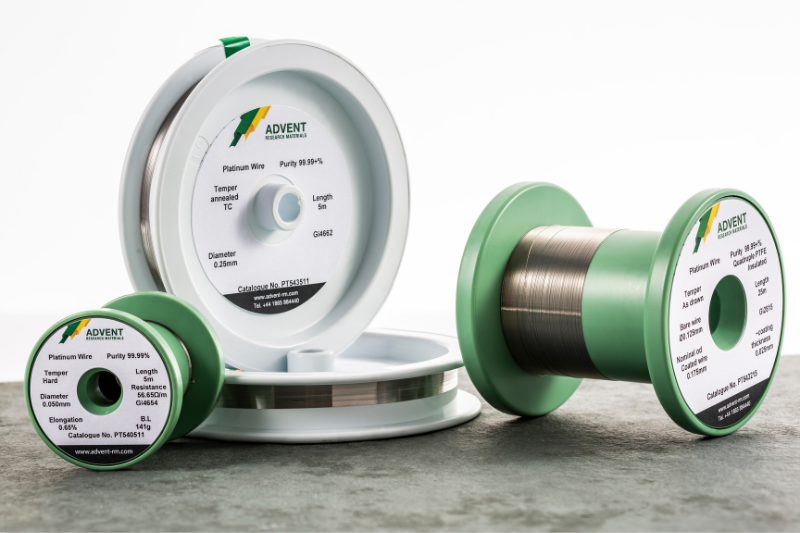Platinum
Advent Research Materials are a leading supplier of Platinum (Pt) in multiple forms including Platinum foil, Platinum wire, insulated wire, Platinum sheet and woven mesh/gauze. You can buy our high purity Platinum online, with a purity of up to 99.999%.
Our online catalogue makes it easy to buy Platinum online.
Why buy Platinum?
The chemical element platinum is one of the most commonly known – not just in the world of science, but in the world of the consumer. This dense and ductile material has many properties that appeal to different audiences, whether it be cast into an engagement ring or used on the operating table.
Platinum is a silver-white noble metal that is more ductile than gold, silver or copper. It has a melting point of 1768.3 degrees Celsius and a boiling point of 3825 degrees Celsius. Sometimes found in deposits within gold-bearing sands, platinum is mined in Colombia and the Ural Mountains of Russia.
As one of the world’s rarer elements, platinum can occur in many commonly used items, if not replaced by a characteristically similar and more affordable substitute.
Much like the element tantalum and its sister metal niobium, platinum is commonly used today for medical purposes, such as laboratory equipment in the form of trays, containers, forceps and electrodes. Tantalum and niobium work as the best substitutes for platinum with regards to acid.
Platinum is highly resistant to acid and also a non-irritant, which makes it ideal for surgeon’s tools, medical implants and bone repair. Its hypoallergenic properties and near-immunity to dents and scratches explain why platinum is so often the material of choice for expensive jewelry.
The path to the discovery of platinum is not quite as clear as many of the more recently found elements. References to the material in English writings have been found as far back as the early 16th century. It was Antonio Ulloa, the Spanish general and explorer, whose writings about the element in 1748 later fuelled Western curiosity about platinum.
One of the most underwhelming modern products that platinum appears in – considering its worth - is perhaps the hand warmer! Used in the metal strip inside the translucent pouches, the platinum acts as a catalyst to convert methyl alcohol vapours into formaldehyde on contact – that’s the clicking noise to you and me. The chemicals inside the warmer become very hot during this process, and the reaction can be reversed and repeated.
This reaction is not restricted to keeping people’s fingers warm. Platinum is used extensively in vehicle manufacture in catalytic converters.
Platinum has a wide variety of uses in scientific research, including for weights and measures standards and for electrical contacts and electrodes which need to resist chemical attack. Fuel cells are also one of the most common scientific inventions that require platinum. By stripping the electron from hydrogen to form single protons, platinum is an excellent catalyst in a fuel cell, albeit a very costly one.
Scientists at Brown University, MIT and other institutes are in a race to try to create a more sustainable substitute for the element in fuel cells to make them more readily available scientists and the public alike. So far, Argonne National Laboratory has found a way to synthesize transition metal-based catalysts to work as a platinum substitute, which is much cheaper.
Although the breakthrough of a substitute for platinum in a fuel cell will have dramatic changes in the world of science, there will be little impact of the high-end jewelry market, as one of the largest appeals is the extravagance of wearing one of the world’s most expensive metals.
Platinum /iridium
An alloy of platinum also used in modern scientific research materials is platinum /iridium. With the chemical stability of platinum and the added hardness of iridium, there are many opportunities for the application of this alloy.
One of the most common uses of platinum iridium is in the making of micro-electrodes. These are designed for the electrical stimulation of nervous tissue and electro-physiological recordings (the study of the electrical properties of biological cells). With a standard alloy ratio of 90:10 (Pt:Ir), it is drawn out into thin wires that do not bend when inserted into the nervous tissue, as pure platinum wires would.
.png?width=50)
Platinum Insulated Wire
| Line Number & Material | Bare Wire Diameter | Purity | Description | |
|---|---|---|---|---|
| PT5430 Platinum Insulated Wire | 0.05 mm | 99.99% | Temper hard. Quadruple PTFE Insulated. | View item |
| PT5431 Platinum Insulated Wire | 0.075 mm | 99.99% | Temper hard. Quadruple PTFE Insulated. | View item |
| PT5432 Platinum Insulated Wire | 0.125 mm | 99.99% | Temper hard. Quadruple PTFE Insulated. | View item |